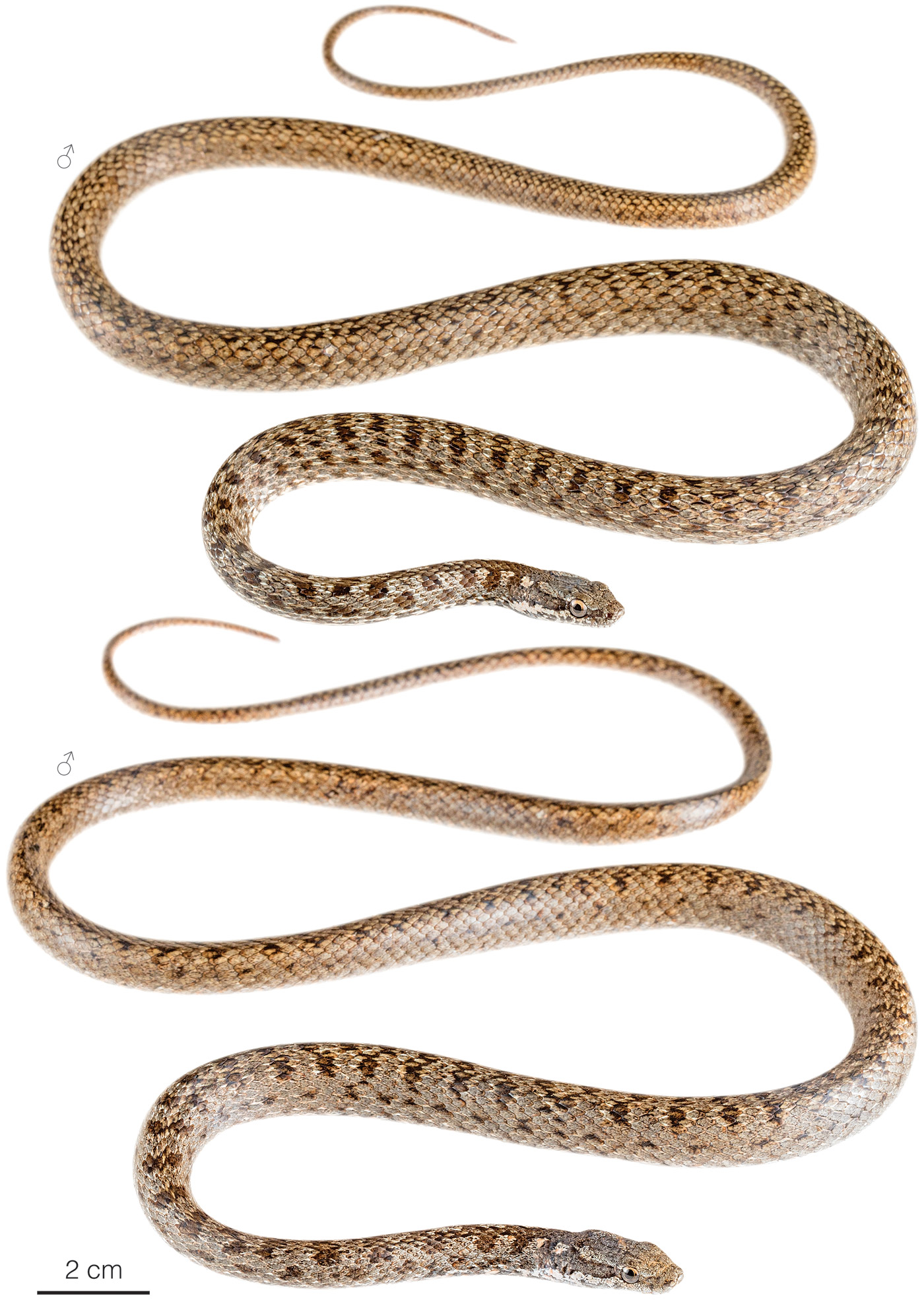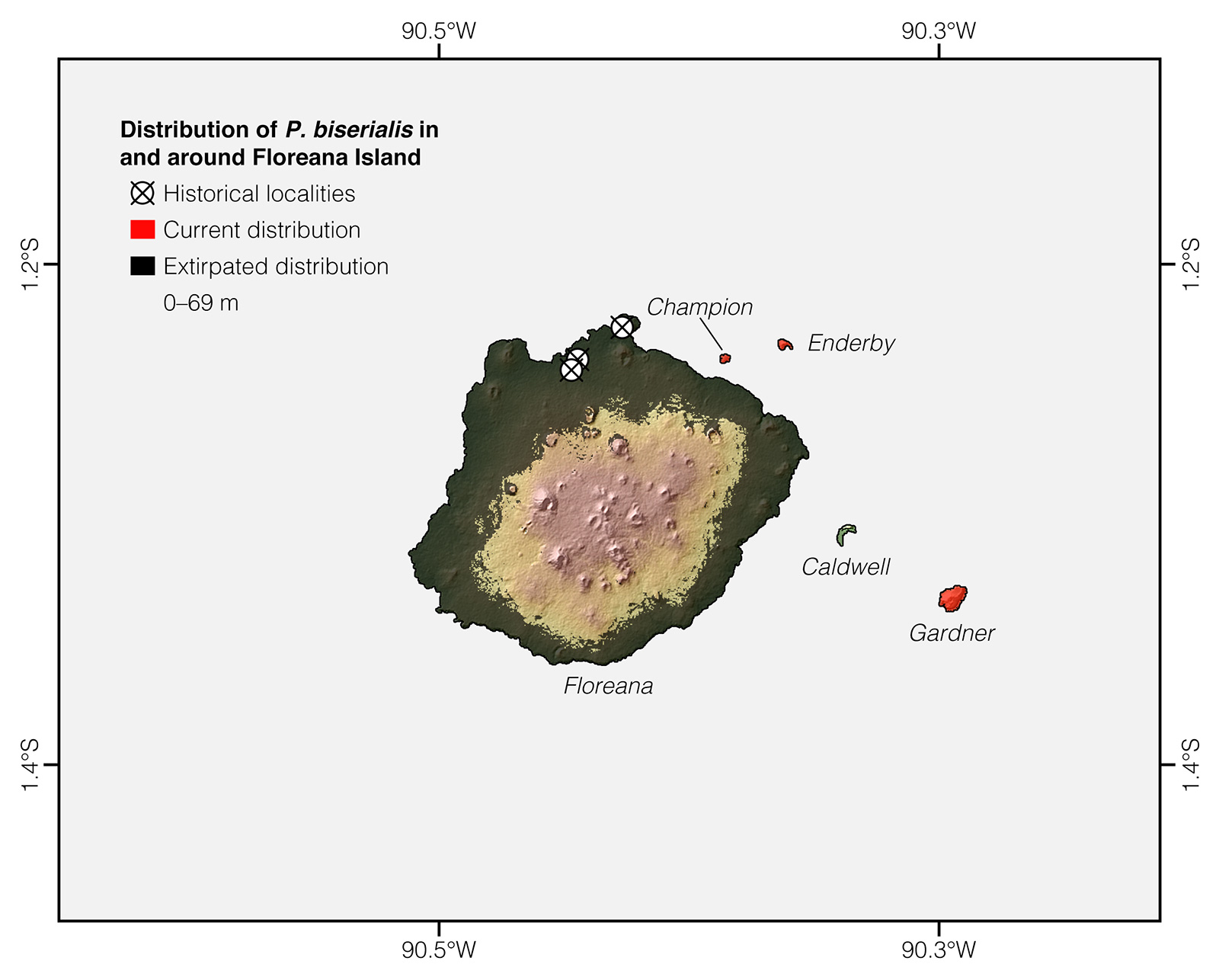Published October 10, 2019. Updated May 24, 2024. Open access.
Southern Galápagos Racer (Pseudalsophis biserialis)
Reptiles of Ecuador | Serpentes | Colubridae | Pseudalsophis biserialis
English common name: Southern Galápagos Racer.
Spanish common name: Culebra sureña de Galápagos.
Recognition: ♂♂ 129 cmMaximum distance from the snout to the tip of the tail. Snout–vent length=92 cm. ♀♀ 126.1 cmMaximum distance from the snout to the tip of the tail. Snout–vent length=96.7 cm..1–3 Pseudalsophis biserialis is the only snake known to occur on the surrounding islets of Floreana Island in Galápagos.1,4 It is characterized by a pale grayish-brown dorsum with a series of irregular dark spots (Fig. 1). This pattern differentiates it from the striped P. eibli, with which it was previously considered conspecific.1–6 Males of P. biserialis differ from females by having a proportionally longer tail.3

Figure 1: Individuals of Pseudalsophis biserialis from Gardner Islet, Floreana Island, Galápagos, Ecuador.
Natural history: Pseudalsophis biserialis is a diurnal and terrestrial snake that inhabits coastal volcanic rock areas, dry shrublands, dry grasslands, and seasonally dry forests.1–7 During daytime, especially between 8:00 am and 5:00 pm, these snakes are typically seen swiftly moving on soil, leaf-litter, and rocks.1,2 Galápagos racer snakes in general are mildly venomous, which means they are dangerous to small prey, but not to humans.1,3 They are active foragers and their diet includes geckos (Phyllodactylus baurii), lava lizards (Microlophus grayii), invertebrates, and birds.1,4 There are recorded instances of predation on juveniles of this species by centipedes of genus Scolopendra.2
Conservation: Near Threatened Not currently at risk of extinction, but requires some level of management to maintain healthy populations..7 Pseudalsophis biserialis is listed in this category because, at the time of the evaluation by the IUCN Red List in 2014, the species was also believed to include the populations on San Cristóbal Island.4 Current knowledge indicates that this snake has been entirely extirpated from Floreana Island and is restricted to just three islets covering an area of only 1.05 km2. This makes P. biserialis the snake with the smallest area of distribution in Ecuador and a prime target for rapid population declines due to stochastic climatic or biological (for example, invasive species) events. Nevertheless, the species seems to have stable population densities.
Distribution: Pseudalsophis biserialis persists only on three of the surrounding islets of Floreana Island (Champion, Enderby, and Gardner) in Galápagos, but it has been extirpated from Floreana (Figs 2, 3).

Figure 2: Distribution of Pseudalsophis biserialis in Galápagos. See Appendix 1 for a complete list of the presence localities included in the map.

Figure 3: Distribution of Pseudalsophis biserialis in Floreana Island. See Appendix 1 for a complete list of the presence localities included in the map.
Etymology: The generic name Pseudalsophis comes from the Greek words pseudo (=false) and Alsophis (a genus of Caribbean snakes), referring to the similarity between snakes of the two genera.3 The specific epithet biserialis comes from the Latin words bis (=double), series (=row), and -alis (=pertaining to).8 It probably refers to the two rows of dorsal spots.1
See it in the wild: Southern Galápagos Racers can be seen almost daily at Champion and Gardner islets, especially during sunny mornings around bird colonies. However, access to these sites is restricted by the Galápagos National Park.
Special thanks to Luis Ortiz-Catedral for symbolically adopting the Southern Galápagos Racer and helping bring the Reptiles of Ecuador book project to life.
Click here to adopt a species.
Author: Alejandro ArteagaaAffiliation: Fundación Khamai, Reserva Arlequín, Ecoruta Paseo del Quinde km 56, Santa Rosa de Mindo, Pichincha 171202, Ecuador.
Photographer: Jose VieirabAffiliation: Tropical Herping (TH), Quito, Ecuador.,cAffiliation: ExSitu, Quito, Ecuador.
How to cite? Arteaga A (2024) Southern Galápagos Racer (Pseudalsophis biserialis). In: Arteaga A, Bustamante L, Vieira J (Eds) Reptiles of Ecuador: Life in the middle of the world. Available from: www.reptilesofecuador.com. DOI: 10.47051/XYJX3008
Literature cited:
- Arteaga A, Bustamante L, Vieira J, Tapia W, Guayasamin JM (2019) Reptiles of the Galápagos: life on the Enchanted Islands. Tropical Herping, Quito, 208 pp. DOI: 10.47051/AQJU7348
- Christian EJ (2017) Demography and conservation of the Floreana racer (Pseudalsophis biserialis biserialis) on Gardner-by-Floreana and Champion islets, Galápagos Islands, Ecuador. PhD thesis, Auckland, Massey University, 186 pp.
- Zaher H, Yánez-Muñoz MH, Rodrigues MT, Graboski R, Machado FA, Altamirano-Benavides M, Bonatto SL, Grazziotin FG (2018) Origin and hidden diversity within the poorly known Galápagos snake radiation (Serpentes: Dipsadidae). Systematics and Biodiversity 16: 614–642. DOI: 10.1080/14772000.2018.1478910
- Cisneros-Heredia DF, Reyes-Puig C (2023) Natural history and conservation of the Galápagos snake radiation. In: Lillywhite HB, Martins M (Eds) Islands and snakes. Oxford University Press, 158–182. DOI: 10.1093/oso/9780197641521.003.0009
- Thomas RA (1997) Galápagos terrestrial snakes: biogeography and systematics. Herpetological Natural History 5: 19–40.
- Mertens R (1960) Über die Schlangen der Galapagos Inseln. Senckenbergiana biologica 41:133–141.
- Márquez C, Cisneros-Heredia DF, Yánez-Muñoz M (2017) Pseudalsophis biserialis. The IUCN Red List of threatened species. Available from: www.iucnredlist.org. DOI: 10.2305/IUCN.UK.2017-2.RLTS.T190541A56253872.en
- Brown RW (1956) Composition of scientific words. Smithsonian Books, Washington D.C., 882 pp.
Appendix 1: Locality data used to create the distribution map of Pseudalsophis biserialis in Ecuador (Fig. 2). Go to the section on symbols and abbreviations for a list of acronyms used.
| Country | Province | Locality | Source |
| Ecuador | Galápagos | Barn Owl Cave | Steadman 1986 |
| Ecuador | Galápagos | Enderby islet | Arteaga et al. 2019 |
| Ecuador | Galápagos | Finch Cave | Steadman 1986 |
| Ecuador | Galápagos | Post Office cave | Steadman 1986 |
| Ecuador | Galápagos | Punta Cormorán | Arteaga et al. 2019 |
| Ecuador | Galápagos | Champion islet | Thomas 1997 |
| Ecuador | Galápagos | Gardner islet | Thomas 1997 |